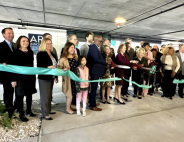
Opportunity Zones and Post-COVID-19 Economic Recovery
02 Apr, 2021
The Opportunity Zone (OZ) tax incentive can play an important role as the U.S. economy emerges from the COVID-19 pandemic. Although the current focus of COVID-19 relief is largely on legislative action to give the economy a boost, OZ is an existing mechanism that the private sector can utilize. The OZ incentive can be an especially nice fit for investors with a focus on impact investing.
Enacted as part of tax reform in 2017, OZ incentivizes private investment in distressed census tracts that have been designated as opportunity zones. Individual and business investors with capital gains can receive significant tax benefits by investing in Qualified Opportunity Funds (QOF) that invest in Qualified Opportunity Zone Businesses (QOZB). Taxes on capital gains invested in a QOF can be deferred until 2026 and enjoy a 10 percent increase in basis if the investment is made by December 31, 2021. If held at least 10 years, gains on the investment in the QOF can be completely free from federal income taxation, no matter how large the gain.
Almost any type of active, for-profit business can potentially qualify to be a QOZB. This can include operating businesses like retail shops, restaurants, grocery stores, and manufacturing, or real estate projects including low income and affordable housing or commercial space. The incentive works across the gamut of industry sectors, including energy, farming, education, high technology, and start-ups.
As with any tax benefit there are rules to qualify as an OZ investment. Following is a brief overview of some of the general requirements. IRS regulations provide several significant exceptions and deviations that offer considerable flexibility in meeting OZ standards.
In general, investors have 180 days from the date of the gain to invest in a QOF. The QOF must invest at least 90 percent of its assets in a QOZB or face an IRS penalty.
In general, the OZ property or business must be located in and operating out of a designated zone. Tangible property must be acquired after December 31, 2017 and be either original use or substantially improved. For an operating business, at least 50 percent of gross revenues must be derived from the active conduct of the business in the OZ, at least 40 percent of intangible assets owned by the business must be used in the OZ, and less than 5 percent of the QOZB’s assets can be held in non-qualified financial property, including cash and certain other financial products. A written working capital plan can operate as a safe harbor to allow additional cash holdings while a project is under construction.
Although regulations have been finalized, legislative proposals are expected from the Biden administration and Congress to require information reporting to better track OZ investments and their outcomes. This is in response to concerns about the transparency of OZ investments and whether they are being directed to appropriate census tracts.
COVID-19 recovery and the focus on economic justice make OZ investments a very timely and apt part of a capital stack. OZ can be combined with other federal, state, local, and tribal incentives, so as Congress considers a post-pandemic economic stimulus plan featuring a wide array of infrastructure priorities, OZ could be a nice fit with incentives offered in that package. Investments can be made into a QOF through the end of 2026. Although a minimum 10-year hold is required to receive the tax-free treatment of gains on investments, final regulations allow QOF investments to be held as late as 2047.
The old saying that there is an exception for every rule seems tailor-made for the OZ incentive. If you are interested in whether OZ is a good fit for your project or business plan, seek good counsel and explore the opportunities!
Side Bar
Kent County, Maryland
Kent County is a scenic peninsula on Maryland’s Upper Eastern Shore of the Chesapeake Bay, ideally situated less than a two-hour drive from Philadelphia, Washington D.C., Annapolis, Dover and Northern Virginia. It is home to two designated Main Streets, an Arts & Entertainment District, historic Washington College, and one of the largest marina communities in Maryland.
Kent County is Open for Business Kent – County is actively providing incentives and workforce development tools to help businesses grow. The County is developing broadband infrastructure and has implemented a 110-mile fiber optic broadband network for high-speed gigabit connectivity. Portions of the County are located within Commerce Zones, an Opportunity Zone, an Enterprise Zone, and a HUBZone. The Department of Economic & Tourism Development works with businesses to identify the tax credits they are entitled to for locating to, and growing within, those designated zones. In addition, the County offers access to programs including the Maryland Commercial Property Assessed Clean Energy (MD-PACE) Program, the Maryland Manufacturing Extension Partnership (MD MEP), and the ExportMD Program.
Business Overview – Kent County is home to a wide variety of businesses in industries including manufacturing, healthcare, education, maritime, aquaculture, agriculture, culinary and professional services. Several of the major employers are world-wide manufacturers. The region has access to a workforce close to 300,000 within a 30-minute drive and the unemployment rate continues to be below the national average. County businesses benefit from no county personal property tax and a variety of tax credits making it a profitable place to do business.
Chestertown Business Campus – The Chestertown Business Campus is one of the largest economic development projects in many years. The 80-acre site is home to Dixon Valve & Coupling’s new distribution facility, new corporate headquarters, a new manufacturing facility, and a new facility for the growing YMCA, currently under construction.
A Gigabit County – Kent County has completed the backbone implementation of a 110-mile fiber optic backbone throughout the county. The county has entered into a public-private partnership with Kent Fiber Optic Systems to provide public institutions with high-speed reliable internet access. KentFOS’ open access network allows Internet Services Providers the ability to offer 1G service to businesses and residences. The primary goal was to enhance the infrastructure needed to support new and existing businesses and organizations in Kent County, particularly with affordable, robust, and high capacity internet access. By taking this action, the county is expanding the competitive capability of local businesses and organizations and providing more opportunities.
Data Center Attraction – Kent County led the efforts to pass a state-wide Sales and Use and Personal Property Tax Exemption for Data Center to locate in Maryland. Low land cost, wide open spaces, access to fiber and access to 17 million people within 100 miles make Kent County an ideal place for data centers to locate. Visit www.kentcounty.com/business/resources/datacenterlocations for more information.
If you could work from anywhere… you would live here.
Side Bar
Indian River County, Florida
Central to Where Your Business Needs to Be Indian River County – Vero Beach, Sebastian, Fellsmere – strikes a perfect balance between business and pleasure. Those who live, work or visit the area find that the local communities are safe and loaded with ecological, cultural, educational and technological amenities. Many corporate-level executives have located their companies to the area because of the executive’s positive vacation experience, or perhaps they own a winter home on Vero’s barrier island.
Located on Florida’s east coast, midway between West Palm Beach and Cape Canaveral, Indian River County is within three hours of over 17 million consumers, or 90% of Florida’s population. It has easy access to markets but is far from urban sprawl, traffic and congestion. Visitors from other parts of Florida are amazed, and pleasantly surprised, at the county’s lack of traffic.
The area is rich in history and natural resources, with 26 miles of unspoiled beaches and scenic lakes, plus some of the best bass fishing available in Blue Cypress Lake. It is also the center of the world-famous Indian River Citrus District.
Indian River County is a cost-competitive location for new or expanding businesses. It has hundreds of acres of low-cost land available for development, much of it located near I-95, a major north-south transportation route along the east coast. The county offers competitive property tax rates, and Florida has no state income tax.
The Opportunity Zone initiative offers investors an even greater reason to consider Indian River County, FL. All properties west of I-95 in Indian River County are designated as an Opportunity Zone and zoned for industrial use, including two shovel-ready industrial parks. State and local incentives are also available to relocating and expanding companies, including property tax abatement, tax refunds, and job training grants.
An available and trainable workforce of approximately 638,000 within an hour’s drive time adds to the county’s appeal as a desirable location. Indian River State College (IRSC) has five campuses located throughout the region, offering 2-year and 4-year degrees as well as several industrial and technical certifications. IRSC is very successful in securing training grants for local employers. They can develop specially-designed training programs in a matter of weeks rather than months.
Because location is central to success, Indian River County isn’t just where you want to be – it’s central to where your business ought to be. It has the perfect blend of everything the Sunshine State has to offer. For more information on locating your company to Indian River County, Florida, contact Helene Caseltine, Economic Development Director with the Indian River Chamber of Commerce, at 772-567-3491 or helenec@indianrivered.com. Or, visit their website at www.indianrivered.com.
BY: MARY BAKER BURKE, Government Affairs Counselor, K & L Gates LLP
Related Posts
-

Pinellas County, Florida Celebrates Ribbon Cutting of the ARK Innovation Center Business Incubator
-

Time To “Pivot, Stretch, And Adapt”
-

More Efficient Agriculture Techniques are Coming into the Focus
-

Logistics Getting on a Quicker, more Focused Track
-

New Ideas Emerge for Both Sustainable and Fossil Fuel Technologies
-

New Goals and New Internet Tech Help Build Base for Advanced Manufacturing
-

Business Services Today Focus on Human Resources, Data Analytics
-

Ready to Shift into High Gear
-

The New Forestry Momentum
-

The Manufacturing Trifecta: Better Design Methods, Streamlined Production, Reduced Costs









